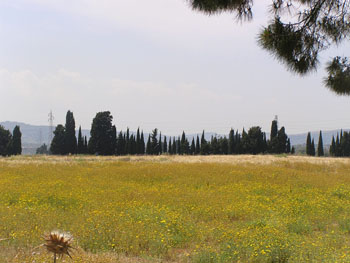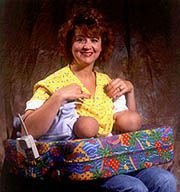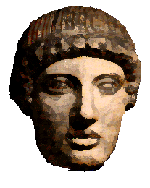Greek sculpture
The kourotrophos from Megara Hyblaea

This amazing sculpture is in the Paolo Orsi Museum in Syracuse (Siracusa, Sicily).
 It's made of limestone, and was in 936 pieces when found, by workmen digging
foundations for one of the petrochemical installations
just south of the site of Megara Hyblaea, on the east coast of Sicily,
a few miles north of Syracuse. Here lay the necropolis (city
of the dead, as still found mockingly mirroring the living city in many
parts of southern Europe) of the small Greek colony (founded by Megarians
from the Greek mainland in about
It's made of limestone, and was in 936 pieces when found, by workmen digging
foundations for one of the petrochemical installations
just south of the site of Megara Hyblaea, on the east coast of Sicily,
a few miles north of Syracuse. Here lay the necropolis (city
of the dead, as still found mockingly mirroring the living city in many
parts of southern Europe) of the small Greek colony (founded by Megarians
from the Greek mainland in about
The unknown artist has created an image of motherhood which is tender and personal as well as monumental and archetypal. Look at the way she's holding the two babies - she's so relaxed, and the children are as comfortable as she is, each with a hand each gently holding on to a breast - both breasts being conveniently exposed through appropriate holes in her tunic. [Has any modern designer come up with as useful a nursing garment? - the "holes" would become slits when not in use, combining modesty and practicality!] The mother has her right hand with her thumb playfully stroking one baby's toes, while her left give's the other twin a little extra support for his head. But there is no tension anywhere: mother and children are so totally at ease and at peace with the world. Mother is in a chair with arms, sitting on her cloak which is outlining her and defining her. Her sturdy toes peep out beneath her tunic.
Who is she? Some play safe and call her "a mother-goddess". I prefer Ross Holloway's conjecture (Archaeology of Ancient Sicily) - she is Night - hence the cloak, nursing her twin sons Sleep and Death (Hypnos and Thanatos): the twins who as young men carry off the corpse of Sarpedon in Iliad 16. This would make it an entirely appropriate, and original, subject for a grave-marker. But the unknown artist has not produced merely an icon - he (or why not she?) has revealed a sensitivity to women and motherhood almost unknown in Greek Art. She's more than just a symbol - she's a real person, even without her head! Remember her when you look at the parade of "beautiful" women in sculpture or on vases, all tailored to the male gaze, fashionably slim, with expressionless faces, naked or artfully draped to accentuate what's concealed. The kourotrophos from Megara Hyblaea has a real figure and wears real clothes - and is the confident owner of her body.
Another (dissenting!) view
 Jenny writes: "...And as for the Kourotrophos: no, sorry, it won't wash. She isn't
in the least at ease with her own body; as a father and man of the world
should know: she's pure male fantasy of maternal bliss. How could the poor
thing possibly be peaceful with twins to feed? You must have talked with
mothers of twins...... You're damned lucky if they ever sleep synchronised,
let alone feed like that. Get real, Wilson!"
Jenny writes: "...And as for the Kourotrophos: no, sorry, it won't wash. She isn't
in the least at ease with her own body; as a father and man of the world
should know: she's pure male fantasy of maternal bliss. How could the poor
thing possibly be peaceful with twins to feed? You must have talked with
mothers of twins...... You're damned lucky if they ever sleep synchronised,
let alone feed like that. Get real, Wilson!"

